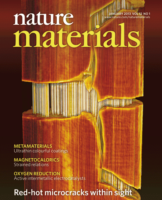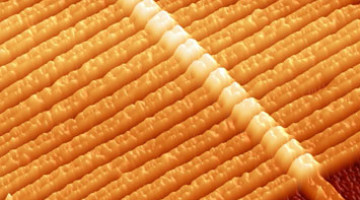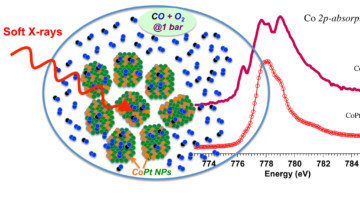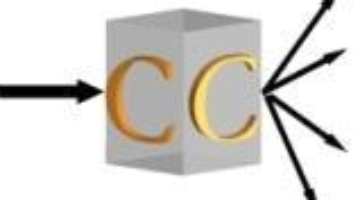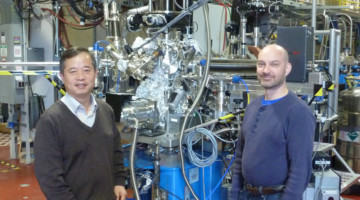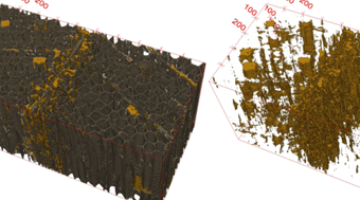Wednesday, May 8 @ 12 noon, USB 15-253 Flipping Out over Topological InsulatorsChris Jozwiak, Scientific Support Group, Beamline 7.0 Playing “Chase the Electron” with Oxides from Chromium to PlutoniumStefan G. Minasian, Chemical Sciences Division, Beamline 11.0 Imaging the Chemistry of (Microbial) LIfeHoi-Ying Holman, Earth SciencesRead More Read more »
Real-Time Quantitative Imaging of Failure Events in Materials Under Load at Temperatures Above 1,600 °C
Gathering information on the evolution of small cracks in ceramic matrix composites used in hostile environments such as in gas turbines and hypersonic flights has been a challenge. It is now shown that sequences of microcrack damage in ceramic composites under load at temperatures up to 1,750 °C can be fully resolved with the use of in situ synchrotron x-ray computed microtomography. Read more »
Moving Memristor and Neuristor Research Forward
HP Labs researchers have tackled a decades-old mystery relying on powerful ALS microscopy techniques—to better understand the fourth basic circuit element: the memristor. The memristor (short for “memory resistor”) joins the other passive elements—the capacitor, the resistor, and the inductor—to create a device with the ability to “remember” changes even when it loses power. Commercial development based on memristors offers the promise of computing systems with highly advanced energy efficiency and memory retention. Memristor-based memory could be a strong competitor for current flash memory.
Chemistry of Cobalt-Platinum Nanocatalysts
Bimetallic cobalt-platinum (CoPt) nanoparticles are drawing attention in many areas of catalysis as scientists tackle the quest to reduce precious metal content while maintaining optimum catalytic selectivity and reactivity. Researchers explored the role of Pt in Co reducing and oxidizing, and found that the catalytic properties of monometallic and bimetallic nanoparticles of Co are closely related to the oxidation state of Co. Read more »![]()
![]()
Crystallographic Consulting Brings Research to the ALS
Crystallographic Consulting has a varied client base that includes many of the participating research team (PRT) members at the Berkeley Center for Structural Biology (BCSB), which operates five ALS beamlines. Crystallographic Consulting also contracts beam time for another 10-12 companies. Most of their research supports pharmaceutical companies working on new treatments for metabolic diseases and cancer.
Chloride Depletion in Aged Sea Salt Particles
Elemental and chemical imaging analyses showed that sea salt particles react with water-soluble organic acids in the atmosphere through a unique mechanism which had been overlooked in atmospheric chemistry. The reactions release volatile hydrogen chloride into the atmosphere and leave behind sea salt particles drained of chloride.
Read more »
February 22, 2013
Friday, February 22 @ 12 noon, USB 15-253 Towards perfect diffraction gratings with x-raysDmitriy Voronov, Experimental Systems Group, Beamline 6.3.2(Read more and watch a video about this work.) Ice: Slippery when dirty?Hendrik Bluhm, Chemical Sciences Group, Beamline 11.0.2 Connecting ALS Users To Our Friendly, Neighborhood, SupercomputerJustin Blair, ExperimentalRead More Read more »
Toyota Invests in Promising Magnesium Battery Research at the ALS
Alternatives to the current lithium-ion-based car batteries are at the forefront of the automotive industry’s research agenda—manufacturers want to build cars with longer battery life, and to do that they’re going to have to find new solutions. One promising battery material is magnesium (Mg)—it is more dense than lithium, it is safer, and the magnesium ion carries a two-electron charge, giving it potential as a more efficient energy source. Magnesium has a high volumetric capacity, which could mean more battery power in a smaller space. However, to bring Mg batteries to the commercial market, researchers must create new electrolytes with improved properties. The x-ray absorption spectroscopy (XAS) facilities at the ALS are vital to understanding the interfaces and active species in Mg batteries.
Cisco Systems Funds “Whisker” Growth Research at the ALS
Understanding “whisker” growth—the spontaneous growth of long filament-like grains on the leads, or “legs,” of electronic components—is key to manufacturing reliable lead-free electrical and electronic equipment. Cisco Systems, one of the world’s largest networking equipment producers, has provided funding and technical support to a group of ALS users from Purdue University to research the mechanism and driving forces for whiskers, with the ultimate goal of defining effective mitigation measures.
Wood-Composites Industry Benefits from ALS Research
With an increased demand for sustainable structures and efficient material use, the building industry is always looking for ways to extend their resources. Wood composites offer an opportunity to do this, saving building costs and in some cases increasing strength and durability. Researchers have used data gathered at the ALS to build a predictive computer simulation model that will provide insight into how certain wood species and adhesive types will interact. Technological advances are contributing to stronger, environmentally friendly composite materials that can be used in wood products such as furniture components or building materials.
- « Previous Page
- 1
- …
- 9
- 10
- 11
- 12
- 13
- …
- 17
- Next Page »
